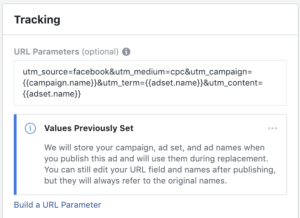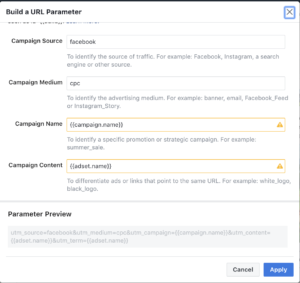If you are advertising on Facebook, chances are you will also be using Facebook conversion pixel and optimize based on the platform’s results. However, when it comes to reporting, I strongly suggest you use Google analytics as your one source of truth. Otherwise, if you advertise on multiple channels, you will most likely end up reporting on the same conversion more then once and you don’t want that!
UTM Tags
UTM tags are the basic fields recognized by Google analytics. These tags will allow you to trace back traffic, conversions and more to a specific channel, campaign or ad. The different tags are:
- Source
- Medium
- Campaign
- Content
- Term
Using the right UTM tags for your Facebook campaigns
For Facebook advertising, you should primordially add source (facebook) and medium (cpc). Using the Campaign tag is also a must if you want any performance details. After that, depending on how you structure your campaigns, and the level of insights you want, you have different options with the two remaining tags.
Content is usually referred to as the content of the ad. You could use it to identify the theme of your ad, or simply use your ad name. Term would be the keywords in Google Ads, but for Facebook, I suggest putting the audience name. Because the audience is at the ad set level, I usually put the audience name as my ad set name.
Why you should use Facebook dynamic parameters and how to use them
Now that we’ve established the structure of your UTM parameters, let’s see how to simplify building these UTM tags. If you only run a few ads, adding all these tags manually, with the right campaign name and the right ad set name doesn’t sound too big of a hassle. But when you have a big account and you have multiple campaigns, ad sets and ads, adding these manually becomes a lot of work and leaves a lot of room for error.
This is where dynamic parameters come in VERY handy. As the name say, these parameters will dynamically input the name of the given field. This way, you can use one UTM for all your ads instead of manually creating one for each.
The different parameters available are:
• ad_id = {{ad.id}}
• adset_id = {{adset.id}}
• campaign_id = {{campaign.id}}
• ad_name = {{adset.name}}
• adset_name = {{adset.name}}
• campaign_name = {{campaign.name}}
Here is the ultimate UTM that I recommend you use for all your ads:
utm_source=facebook&utm_medium=cpc&utm_campaign={{campaign.name}}&utm_term={{adset.name}}&utm_content={{adset.name}}
I dream of the day where Facebook will allow us to ad the tracking parameters at the campaign level or even at the ad set level. Just like you can add tracking template at the campaign level or ad group level in Google or Bing. This would be a lot faster to implement, but for now, this parameter can only be set at the ad level under tracking and URL Parameters.

I would like to bring your attention to a very important piece of information. As Facebook warns us, the dynamically inputed value will be the original.
We will store your campaign, ad set, and ad names when you publish this ad and will use them during replacement. You can still edit your URL field and names after publishing, but they will always refer to the original names
This means you need to be very careful when creating a new campaign, ad set or ad and make sure to name them properly as this is what will appear in Google Analytics even if you rename them.
If you want to use a different UTM, you can use Google’s UTM builder or you can use Facebook “Build a URL Parameter” tool directly in the ad.


